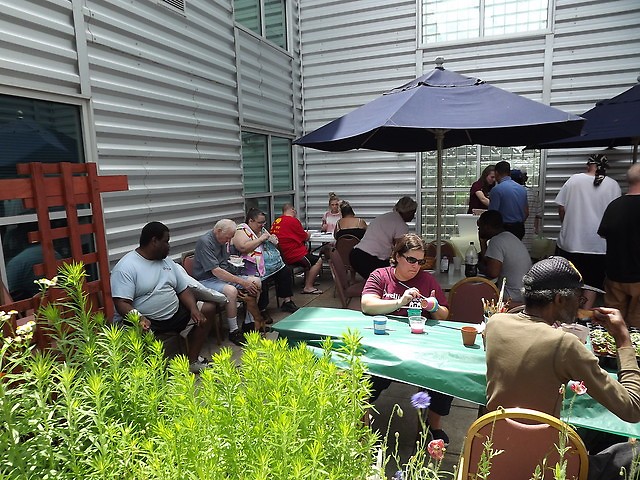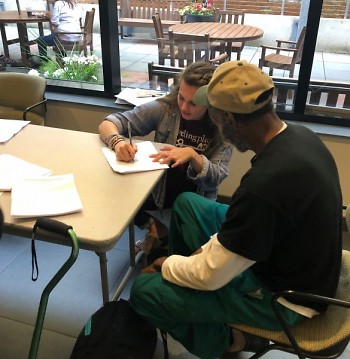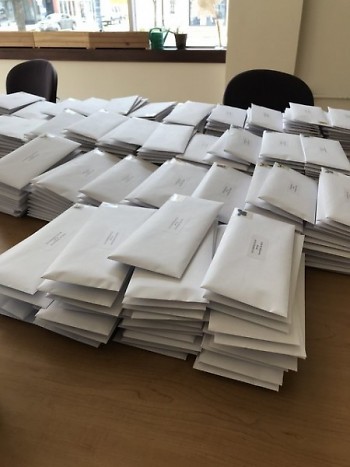“You can build all the buildings in the world, but unless you create relationships and connections with residents, things won’t happen,” explains Suzanne Schultz, the outgoing Managing Director of Design and Development for the City of Grand Rapids Planning Department. This comment, made in reference to a community survey that is once again being conducted in the Heartside Neighborhood, serves as the foundation for the importance of voice-driven data.
The Heartside Resident Satisfaction survey, administered by Dwelling Place and funded by NeighborWorks America, serves as a documentation of the thoughts and feelings of Heartside residents about their neighborhood. The survey was first conducted three years ago in 2016 and is being conducted again in the summer of 2019. Eligible to individuals who live and reside in permanent addresses within the Heartside Neighborhood, from Wealthy to Fulton and Lafayette to the Grand River, the survey measures satisfaction levels on topics such as neighborhood safety, local development, resident voice, and community efforts.
After completing this year’s survey, longtime Heartside resident Cynthia Noorman gave her perspective about the survey. She believes it allows residents' voices to be heard, saying, “I think [the survey] has made an impact because those people who are doing the survey give other people a voice.” She goes on to explain that for, “even something little we put in [the survey] there are a lot of people in the neighborhood feeling the same way. Some people might just tell people about [an issue] and some people might write it down in a survey.”
As a nonprofit housing corporation that specializes in neighborhood revitalization and affordable housing, Dwelling Place is well-situated to collect a representative data set; its long-standing presence in the neighborhood allows it to capture voices from the fringes, voices that typically would go unheard in large-scale data collection.
After the previous study in 2016, Suzanne Schultz, along with other City of Grand Rapids officials, local nonprofits, and residents, saw the data as a catalyst. The responses in the 2016 study were so robust, the City of Grand Rapids recognized a need to launch an in-depth neighborhood action project known as the Heartside Quality of Life Study. This process took voice a step further, giving community members and resident leaders the authority to create the type of change that neighbors wanted to see. A diverse network of seven active workgroups based on the topics and concerns that were presented in the 2016 survey met regularly and addressed issues such as fresh food access, public restrooms, substance abuse and mental health advocacy, and other areas of improvement.
From these efforts, concrete change started taking place in the neighborhood, such as funding being allocated by the City for the implementation of public restrooms and the improvement of fresh food access to the neighborhood through partnership with the YMCA Veggie Van, improvements to Pekich Park, changes at Lucky’s Liquor, free Mental Health First Aid training being brought to the neighborhood, establishment of the Heartside-Downtown Neighborhood Association, and even more changes (detailed in the Heartside Quality of Life report). These changes resulted from the hard work of many in public and private sectors, but most importantly the residents of the community.
Micah Morris, who has been a Heartside resident for many years, remarked on the importance of the survey for community change. “[It was] great to get other’s opinions and get feedback on how people view [Heartside] and make change to accommodate [people’s needs].” He also mentioned that one of the best ways he sees change created is through “how we deal with one another, by seeking information, and talking to one another and not at one another.” This process of “talking to one another and not at one another” is the function that the survey intends to fulfill: to be a jumping-off point for neighbors who can dig into problem-solving together.
The residue of the survey results still holds changing precedence in the Heartside community. That’s why this year’s survey is so important to the growth and change of the neighborhood. It provides valuable insight into the progress of the previous survey’s results and acts as the tracker for what still needs to be addressed. Under any community change, it’s imperative that resident voice and perspective is the foundation. As a resident in your community, what are ways that you are allowing your voice to shape the systems in which you live? As a community partner, how are you listening to those resident voices? Residents living in Heartside can still participate in the survey, email [email protected] with requests for a digital link!
With a mission to improve the lives of people by creating quality affordable housing, providing essential support services and serving as a catalyst for neighborhood revitalization, Dwelling Place serves families and people in 4 counties across West Michigan. Dwelling Place is powered by volunteers and numerous staff persons, guest writers create our Rapidian content. Thanks to Julia Ervin for her contribution of this piece. Julia is a summer AmeriCorps member who will be returning to Dwelling Place this fall for a year long placement. Julia has a heart for Heartside and has worked at Heartside Ministries, supported the launch of the Semester in Grand Rapids program at GVSU and is a former participant in semester in Detroit.
The Rapidian, a program of the 501(c)3 nonprofit Community Media Center, relies on the community’s support to help cover the cost of training reporters and publishing content.
We need your help.
If each of our readers and content creators who values this community platform help support its creation and maintenance, The Rapidian can continue to educate and facilitate a conversation around issues for years to come.
Please support The Rapidian and make a contribution today.


